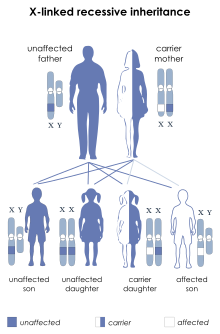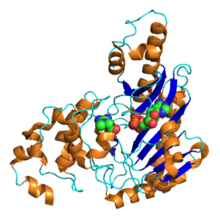Becker muscular dystrophy
| Becker muscular dystrophy | |
|---|---|
| Other names | Benign pseudohypertrophic muscular dystrophy[1] |
 | |
| X-linked recessive is the manner in which this condition is inherited | |
| Specialty | Neurology |
| Symptoms | Severe upper extremity muscle weakness,[2] Toe-walking[3] |
| Causes | Mutations in DMD gene[4] |
| Diagnostic method | Neurological exam, muscle exam[3] |
| Treatment | No current cure, Physical therapy [3] |
Becker muscular dystrophy (BMD) is an
While there is no known cure, management strategies such as
Other medications used include
Signs and symptoms
Some symptoms consistent with Becker muscular dystrophy are:
Individuals with this disorder typically experience progressive muscle weakness of the leg and pelvis muscles, which is associated with a loss of muscle mass (wasting). Muscle weakness also occurs in the arms, neck, and other areas, but not as noticeably severe as in the lower half of the body. Calf muscles initially enlarge during the ages of 5–15 (an attempt by the body to compensate for loss of muscle strength), but the enlarged muscle tissue is eventually replaced by fat and connective tissue (pseudohypertrophy) as the legs become less used (with use of wheelchair).[medical citation needed]
Complications
Possible complications associated with muscular dystrophies (MD) are cardiac arrhythmias.[11] Becker muscular dystrophy (BMD) also demonstrates the following:
Genetics
The gene affected is the DMD gene, is located on the X
The DMD gene can be broken down into four different regions: the N terminal, rod, cysteine-rich, and carboxy terminal.[13] This is the largest gene/protein in the human body, and due to its size, can have many different mutations affecting it and therefore differing clinical presentations.[citation needed]For example some patients with Becker's can be asymptomatic aside from blood work abnormalities, and some can present with progressive muscle weakness, heart defects, and difficulty with activities of daily living.[citation needed]Some literature even describes unique cases where muscle pain, cramping, and elevated creatine kinase levels are the only presenting symptoms instead of the classic presentation of muscle weakness.[16]
Becker muscular dystrophy occurs in approximately 1.5 to 6 in 100,000 male births, making it much less common than Duchenne muscular dystrophy. Symptoms usually appear in men at about ages 8–25, but may sometimes begin later.[17] Genetic counseling may be advisable when potential carriers or patients want to have children. Sons of a man with Becker muscular dystrophy do not develop the disorder, but daughters will be carriers (and some carriers can experience some symptoms of muscular dystrophy), so the daughters' sons may develop the disorder.[18]
Diagnosis

In terms of the diagnosis of Becker muscular dystrophy symptom development resembles that of Duchenne muscular dystrophy. A physical exam indicates lack of pectoral and upper arm muscles, especially when the disease is unnoticed through the early teen years. Muscle wasting begins in the legs and pelvis, then progresses to the muscles of the shoulders and neck. Calf muscle enlargement (pseudohypertrophy) is quite obvious. Among the exams/tests performed are:[19][20]
- Muscle biopsy (removes a small piece of muscle tissue, usually from the thigh, to check for dystrophin in muscle cells.)
- Creatine kinase test (checks the level of Creatine Kinase proteins in the blood. Creatine Kinase proteins are normally found inside of healthy muscle cells, but can be found in the blood when muscle cells are damaged.)
- Electromyography (shows that weakness is caused by destruction of muscle tissue rather than by damage to nerves.)
- Genetic testing (looks for deletion, duplication, or mutation of the dystrophin gene.)
Treatment
There is no known cure for Becker muscular dystrophy yet. Treatment is aimed at control of symptoms to maximize the quality of life which can be measured by specific questionnaires.
Immunosuppressant steroids have been known to help slow the progression of Becker muscular dystrophy.[23] The drug prednisone contributes to an increased production of the protein utrophin which closely resembles dystrophin, the protein that is defective in BMD.[24]
The cardiac problems that occur with EDMD and myotonic muscular dystrophy may require a
The investigational drug Debio-025 is a known inhibitor of the protein cyclophilin D, which regulates the swelling of
Prognosis
The progression of Becker muscular dystrophy is highly variable—much more so than Duchenne muscular dystrophy. There is also a form that may be considered as an intermediate between Duchenne and Becker MD (mild DMD or severe BMD). Severity of the disease may be indicated by age of the patient at the onset of the disease. One study showed that there may be two distinct patterns of progression in Becker muscular dystrophy. Onset at around age 7 to 8 years of age shows more cardiac involvement and trouble climbing stairs by age 20, if onset is around age 12, there is less cardiac involvement.[19][28]
The quality of life for patients with Becker muscular dystrophy can be impacted by the symptoms of the disorder. But with assistive devices, independence can be maintained. People affected by Becker muscular dystrophy can still maintain active lifestyles.[29]
Research
There is no cure for any type of muscular dystrophy group.
History
Becker muscular dystrophy is named after the German doctor Peter Emil Becker who published an article about it in 1955.[32][33]
References
![]() This article incorporates public domain material from websites or documents of the Centers for Disease Control and Prevention.
This article incorporates public domain material from websites or documents of the Centers for Disease Control and Prevention.
- ^ "Becker muscular dystrophy: MedlinePlus Medical Encyclopedia". medlineplus.gov. Retrieved 30 July 2019.
- ^ a b c d e f g "Becker's Muscular Dystrophy information. Patient". 12 June 2023.
- ^ a b c d e f g h i "Becker muscular dystrophy". NIH. Retrieved 17 April 2016.
- ^ a b "Becker muscular dystrophy | Genetic and Rare Diseases Information Center (GARD) – an NCATS Program". Archived from the original on 2016-04-28. Retrieved 2016-04-19.
- ^ "Duchenne and Becker muscular dystrophy". NIH.gov. NIH. Retrieved 17 April 2016.
- ^ a b c d e f "Muscular Dystrophy: Hope Through Research". NINDS. March 4, 2016. Archived from the original on 30 September 2016. Retrieved 12 September 2016.
- PMID 29301272.
- ^ "Muscular Dystrophy, Becker". NORD (National Organization for Rare Disorders). Retrieved 2021-04-17.
- ^ a b c d e "NINDS Muscular Dystrophy Information Page". NINDS. March 4, 2016. Archived from the original on 30 July 2016. Retrieved 12 September 2016.
- ISBN 9781604562644. Retrieved 19 April 2016.
- ^ "Cardiovascular Complications Associated with Muscular Dystrophy".
- ^ a b "Error 403".
- ^ PMID 3410474.
- ^ a b Becker Muscular Dystrophy~clinical at eMedicine
- PMID 20301298.
- S2CID 253733072.
- S2CID 20687867.
- PMID 23620649.
- ^ a b "Becker muscular dystrophy | Genetic and Rare Diseases Information Center (GARD) – an NCATS Program". Archived from the original on 2016-04-28. Retrieved 2016-04-19.
- ^ RESERVED, INSERM US14 – ALL RIGHTS. "Orphanet: Becker muscular dystrophy". www.orpha.net. Retrieved 2016-04-19.
{{cite web}}: CS1 maint: numeric names: authors list (link) - S2CID 25834947.
- ^ PMID 31788661.
- ^ "Duchenne/Becker Treatment and Care | Muscular Dystrophy | NCBDDD | CDC". www.cdc.gov. Retrieved 2016-04-19.
- ^ "Dystrophinopathies Treatment & Management: Medical Care, Consultations, Activity". 2017-01-07.
{{cite journal}}: Cite journal requires|journal=(help) - PMID 21245364.
- PMID 18641676.
- S2CID 41929569.
- ISBN 978-0-7817-4130-9.
- ^ "Facts | Muscular Dystrophy | NCBDDD | CDC". 2018-04-10.
- ^ "Muscular Dystrophy Information Page: National Institute of Neurological Disorders and Stroke (NINDS)". July 30, 2016. Archived from the original on 30 July 2016.
- ^ a b "Muscular Dystrophy: Hope Through Research". September 30, 2016. Archived from the original on 30 September 2016.
- S2CID 22284081.
- PMID 13469170.
Further reading
- "Becker Muscular Dystrophy (for Parents)." Edited by Mena T. Scavina, KidsHealth, The Nemours Foundation, Mar. 2018, kidshealth.org/en/parents/becker-md.html.
- Gaudio, Daniela del; Yang, Yaping; Boggs, Barbara A.; Schmitt, Eric S.; Lee, Jennifer A.; Sahoo, Trilochan; Pham, Hoang T.; Wiszniewska, Joanna; Craig Chinault, A.; Beaudet, Arthur L.; Eng, Christine M. (September 2008). "Molecular diagnosis of Duchenne/Becker muscular dystrophy: enhanced detection of dystrophin gene rearrangements by oligonucleotide array-comparative genomic hybridization". Human Mutation. 29 (9): 1100–1107. S2CID 21437006.
- Li, Xihua; Zhao, Lei; Zhou, Shuizhen; Hu, Chaoping; Shi, Yiyun; Shi, Wei; Li, Hui; Liu, Fang; Wu, Bingbing; Wang, Yi (2015). "A comprehensive database of Duchenne and Becker muscular dystrophy patients (0–18 years old) in East China". Orphanet Journal of Rare Diseases. 10 (1): 5. PMID 25612904.
External links
- Becker muscular dystrophy at Curlie
